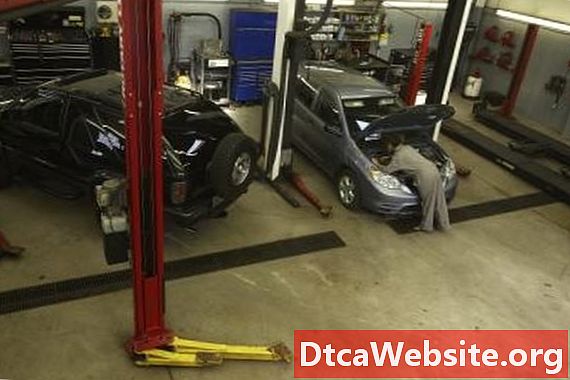
Contenu
- Step 1
- Step 2
- Step 3
- Step 4
- Step 5
- Step 6
- Step 7
- Step 8
- Step 9
- Step 10
- Step 11
- Step 12
- Step 13
- Step 14
- Tips
- Warning
- Items you will need

Most household equipment that draws 30 amps, such as clothes driers and ovens, is operated on 220-volt circuits and therefore uses dual pole circuit breakers. A recreational vehicle (RV) acts as a single appliance when plugged into shore power by a single cable. As an RV comprises many individual pieces of equipment like air conditioners, galley equipment and entertainment systems, it draws a large amount of power but can only use 120-volt current. A new 120-volt 30 amp electric service for an RV must therefore be fused by a single pole 30 amp circuit breaker.
Step 1
Consider access, exposure to rain and the potential for accidental damage when deciding where to locate the new 120 volt 30 amp outlet.
Step 2
Use a deep-lid weatherproof box if fitting the new outlet outside. Lift away its front section and mark the wall it is to be fixed to by marking through at least two of the small holes at the back.
Step 3
Use size-eight screws to fix the weatherproof box if fixing to a timber or stud wall. Use an electric drill with a 1/8-inch masonry bit to drill holes if fixing to a masonry wall, then pack the holes with 3/8-inch wall-anchors, and use size-eight screws to fix the weatherproof box firmly.
Step 4
Remove one knock-out perforated circular panel from the sides of the box and locate the metal junction box inside the deep-lid weatherproof box. Ensure it is oriented so that the knock-out hole points downward. Secure the metal junction box to the wall again, using tools and materials appropriate to the substrate.
Step 5
Use the main switch of the breaker board to completely switch off the electrical supply. Unscrew and lift out the front panel inside the breaker box, which is called a dead-front panel. Use a voltage meter to confirm that no current is present after the main switch.
Step 6
Trim six inches from the outer jacket at one end of the wire using your craft knife. Do not cut into the insulation encasing the three separate wires inside. Do not use American Wire Gauge (AWG) wire greater than size 10 or less than size 22.
Step 7
Use wire strippers to trim half an inch of insulation from each of the separate wires. Turn the strands of the separate wires between your fingers to make three rigid copper pins that that look like pieces of rope.
Step 8
Slip the wire into the breaker box through an unused knock-out hole in its side close to an unused 30 amp breaker. Attach the green wire to the common ground block. Attach the black or red wire to the output side of a vacant 30-amp breaker. Attach the white wire to an unused terminal in the neutral bus-bar. Be very careful: Although this area of the breaker box is dead, the terminals above the main switch will still be live. Screw the dead-front panel back in place as soon as this part of the project is finished.
Step 9
Route the wire to the location of the camper outlet, ensuring there are no loose loops or pendant areas that could create a trip hazard. Make sure the wire is not over-tight so as to create strain points at corners and joins. Secure the wire at eight-inch intervals with proprietary cable clips.
Step 10
Slip the free end of the wire into the weatherproof box and through the knock-out hole in the metal box. Feed the wire in until 10 inches are protruding from the metal box. This must be done from underneath so that rain cannot run into the assembly through the hole or along the wire.
Step 11
Strip away two inches of casing with the craft knife, again ensuring you do not damage the insulation of each internal wire, then use wire strippers to trim half an inch of insulation from each of the separate wires. Turn the strands of the separate wires between your fingers as before.
Step 12
Grasp the TT-30R so that the pin-slots are away from you and install the wires. Observe the industry-standard color codes to mate the correct wires with the correct terminals. Viewed from the back, the lower right-hand screw takes the black, hot wire; the lower left-hand screw takes the white, neutral wire; the upper screw takes the green (sometimes bare), ground wire. Tighten each terminal-securing screw individually as you fit the wire into the hole. It is imperative that no part of the bared, twisted wires protrudes from the holes after the terminal securing screws have been tightened.
Step 13
Depress the TT-30R into the metal box, keeping any spare wire loose as it coils around the inner rim. Screw holes in the TT-30R will align with tabs inside the metal box. Install the fasteners that came with the outlet.
Step 14
Depress the TT-30R into the metal box, keeping any spare wire loose as it coils around the inner rim. Screw holes in the TT-30R will align with tabs inside the metal box. Install the fasteners that came with the outlet.
Insert the RVs umbilical into the new outlet. If a weatherproof box was used, replace the outer rain cover and ensure it closes properly over the plug.
Tips
- It is possible with some products to align the holes in the deep-lid weatherproof box and the metal wall box. If so, pass your screws through the metal wall box and then through the deep-lid weatherproof box and secure them both at the same time.
- The green or bare ground wire must be attached to the U shaped upper pin if no screw is painted green.
Warning
- Live electricity is deadly. Always double-check power is OFF when working with electrical circuits.
Items you will need
- Felt-tip marker
- Electric drill
- Screwdriver
- Voltage meter
- Craft knife
- Wire strippers
- Deep-lid weatherproof box with flip-up cover
- Size eight wood screws
- 1/8-inch masonry bit and 3/8-inch wall-anchors
- Metal junction box
- Type UF--rated
- TT-30R outlet
- Cable clips


